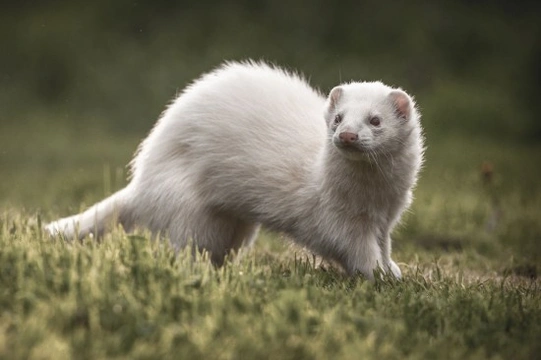
10 of the Most Interesting and Useful Ferret Facts
1. Ferret Keeping is not a Recent Phenomenon
Ferrets are the domesticated form of the European polecat, but the exact history of domestication is unknown. It is thought that they have been kept as pets for thousands of years, and supportive evidence shows them depicted in ancient tapestries and paintings. Aristotlelists the ferret in his_Historia Animalium_, written about320 BC. Originally they were used for hunting rabbits, and some still are kept for this purpose. They are becoming increasingly popular in the UK, although they do not yet feature in the Pet Food Manufacturers’ Association Top 10 UK Pets List (as of June 2014). The 2004 movie “Along Came Polly” featuring Jennifer Aniston, Ben Stiller and Jack the ferret (his name was Rodolfo in the film) showed the non-ferret savvy what quirky and delightful creatures they can be. The ferret is very popular indeed in North America.
2. Ferrets are not Rodents
This is a common misconception – ferrets are “mustelids”. Ferrets are the domesticated members of the Order Carnivora, FamilyMustelidaeand GenusMustela. Unlike rodents, ferrets are obligate carnivores. Some of their close relatives are weasels, stoats, otters and badgers. The mustelid family are actually the largest in the order Carnivora!
3. The Distinctive Ferret Odour
Mustelids (apart from the sea otter) all have a very distinctive odour, which originates from the strong smelling secretion from their anal scent glands used for sexual signalling and for marking territory. Male ferrets (hobs) smell more than females (jills), and this is intensified during their breeding season (which is usually from March to September in the UK). Neutering will reduce the odour. Routine de-scenting is illegal in the UK.
4. Why Unbred Jills Should be Spayed
Jills are induced ovulators, which means that they will remain in heat (oestrus) indefinitely until they are bred and no eggs are released until they mate. This can prove fatal should aplastic anaemia develop as a result of the high level of oestrogen suppressing the production of blood cells in the bone marrow. Other risks include false pregnancies, unwanted pregnancies and pyometra (infection of the womb).
5. Sleeping Habits
Ferrets play hard, but they also need their sleep to recuperate and regenerate. In fact they are masterful sleepers and can sleep for up to 18 hours a day. They are known for sleeping deeply, and some are such sound sleepers that it may be possible to carefully clip claws or examine ears without arousing the ferret if these procedures are difficult to do normally. Ferrets appreciate comfortable beds and many love to snooze in a hammock. They do sometimes fall asleep in unusual places and at odd times though. Many an owner has found their “lost” ferret asleep in a drawer or somewhere unexpected.
6. Hoarding
The word ‘ferret’ comes from the Latin for ‘thief’ and this is a very apt name since a ferret’s natural instinct is to hide their food to keep it safe from other animals. They do not always limit their stash to food though, and some owners have reported that their ferrets stow away all sorts of items ranging from jewellery and keys to larger objects such as mobile phones!
7. Intelligence
Ferrets are incredibly intelligent creatures and are capable of learning how to respond to both verbal and visual commands. They are easy to litter train, and can be taught to walk on a harness and leash and even learn some tricks.
8. Influenza
Ferrets can be susceptible to catching the influenza virus from humans. They can also pass it to us, although it is more likely that we would infect our ferrets than the other way around. Ferrets can become seriously unwell if we transmit the virus to them so it’s very important to seek prompt veterinary advice if your ferret is showing any symptoms. Like us, they may experience coughing, sneezing, discharge from the eyes and nose, lethargy and inappetence. Ferrets are also susceptible to the H7N9 avian flu virus.
9. Ferrets are Useful!
On 1st April 2010, Virgin Media revealed (via an article in the Telegraph), that the company was using "specially trained ferrets" to help lay cables to expand broadband service to rural areas. This was actually an April Fool’s Day hoax, but ferrets really have been employed in some rather unusual capacities over the years. In the1960's,the Boeing Aircraft Corporation used them to lay guide-wires that pull heavier cables through conduits. More recently, ferrets helped to lay TV and sound cables for the wedding of Prince Charles and Lady Diana Spencer, and the Millennium Pop Concert in Greenwich Park.
10. Designer Ferrets
Most ferrets are either albino (white with pink eyes) or sable in colour (like the polecat). Albinos are typically preferred for hunting as they are easier to locate in the field. Sable colouring can vary in depth and hue. More recently, “designer” colourings and patterns such as “badger” and “panda” have become fashionable, but unfortunately for the ferret, these patterns make the ferrets more susceptible to developing a congenital defect called Waardenburg syndrome. This results in a broadening of the skull and deafness.



